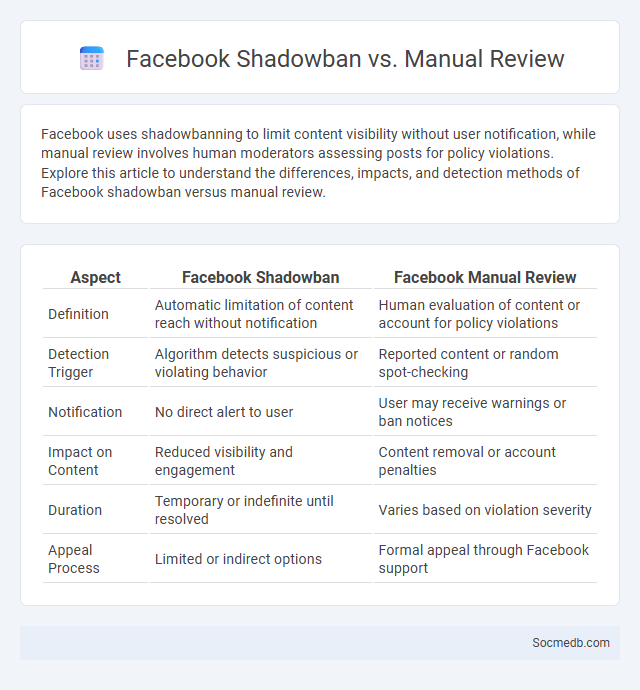
Photo illustration: Facebook Shadowban vs Manual Review
Facebook uses shadowbanning to limit content visibility without user notification, while manual review involves human moderators assessing posts for policy violations. Explore this article to understand the differences, impacts, and detection methods of Facebook shadowban versus manual review.
Table of Comparison
| Aspect | Facebook Shadowban | Facebook Manual Review |
|---|---|---|
| Definition | Automatic limitation of content reach without notification | Human evaluation of content or account for policy violations |
| Detection Trigger | Algorithm detects suspicious or violating behavior | Reported content or random spot-checking |
| Notification | No direct alert to user | User may receive warnings or ban notices |
| Impact on Content | Reduced visibility and engagement | Content removal or account penalties |
| Duration | Temporary or indefinite until resolved | Varies based on violation severity |
| Appeal Process | Limited or indirect options | Formal appeal through Facebook support |
Understanding Facebook Shadowban: An Overview
Facebook shadowban restricts the visibility of your posts without notifying you, affecting reach and engagement on the platform. Algorithms detect content that violates community standards or appears spammy, triggering restricted distribution. Understanding the causes of a Facebook shadowban helps you adjust your content strategy to maintain your audience interaction and avoid penalties.
What Is Manual Review on Facebook?
Manual review on Facebook is a process where human moderators assess content flagged by automated systems or users to determine if it violates community standards. This review ensures nuanced decisions on posts, comments, or ads that algorithms might misinterpret, especially in complex contexts like hate speech, misinformation, or sensitive political content. By combining technology with human judgment, manual review helps maintain platform integrity and user safety.
Shadowban Explained: Social Media Context
Shadowban is a covert social media restriction where content visibility is limited without user notification, often reducing engagement and reach. It targets posts or accounts that violate platform guidelines or exhibit suspicious behavior, such as spamming or excessive hashtag use. Understanding shadowban mechanics helps users optimize content strategies to maintain organic growth and avoid algorithmic penalties.
Key Differences: Facebook Shadowban vs Standard Shadowban
Facebook shadowban restricts the visibility of posts or accounts within the platform without notifying users, primarily targeting behaviors that violate Facebook's Community Standards. In contrast, standard shadowban extends beyond a single platform, often affecting user content across multiple social media sites due to algorithms detecting spammy or suspicious activity. Facebook shadowban specifically limits post reach and engagement within Facebook's ecosystem, while standard shadowban impacts broader online presence and cross-platform user interactions.
Facebook Shadowban vs Manual Review: Core Distinctions
Facebook shadowban limits content visibility by restricting reach without notifying the user, often triggered by algorithmic detection of policy violations or spam-like behavior, while manual review involves human moderators actively assessing flagged content or accounts for specific breaches. Shadowbanning primarily affects organic distribution and engagement metrics silently, whereas manual review can lead to explicit warnings, content removal, or account suspensions based on detailed evaluation. Understanding these core distinctions helps users navigate Facebook's enforcement mechanisms and optimize content compliance effectively.
How Facebook Detects and Applies Shadowbans
Facebook detects shadowbans by analyzing user behavior patterns, engagement rates, and content compliance with community standards through advanced algorithms and machine learning models. Your posts may be restricted or hidden from broader audiences if flagged for misinformation, spam, or policy violations, significantly reducing visibility without notifying you directly. This system helps Facebook maintain platform integrity by limiting the reach of problematic content while keeping user experience intact.
Manual Review Process: Step-by-Step on Facebook
Facebook's Manual Review Process involves an expert team systematically evaluating flagged content based on community standards and policies. The review includes verifying authenticity, context, and potential harm, ensuring accurate decision-making beyond automated detection. This thorough approach maintains platform integrity by addressing complex cases and minimizing false positives.
Identifying If You’ve Been Shadowbanned
Shadowbanning on social media occurs when your posts, comments, or account visibility are secretly limited by the platform, reducing your content's reach without notification. You can identify a shadowban by monitoring sudden drops in engagement metrics like likes, shares, or comments, or by checking if your posts appear under relevant hashtags in incognito mode or through another account. Using analytics tools to track changes in your audience interactions and searching for your content from a non-connected account can help confirm if your social media presence has been restricted.
Avoiding Shadowbans and Manual Reviews: Best Practices
Maintaining consistent posting schedules and avoiding spammy behaviors like excessive hashtag use help prevent shadowbans on social media platforms. Engaging authentically with followers and adhering to community guidelines reduce the likelihood of manual reviews by content moderators. Utilizing platform analytics to monitor reach and interaction patterns enables timely adjustments to content strategy, minimizing the risk of visibility restrictions.
Recovering from Facebook Shadowban or Manual Review
Recovering from a Facebook shadowban or manual review requires identifying shadowban symptoms such as reduced reach, engagement, and visibility on posts. Users should review Facebook's Community Standards and remove any content that violates policies to ensure compliance and avoid further penalties. Engaging in authentic interactions, diversifying content strategies, and appealing through Facebook's support channels increases the chances of lifting restrictions and restoring normal account functionality.
 socmedb.com
socmedb.com